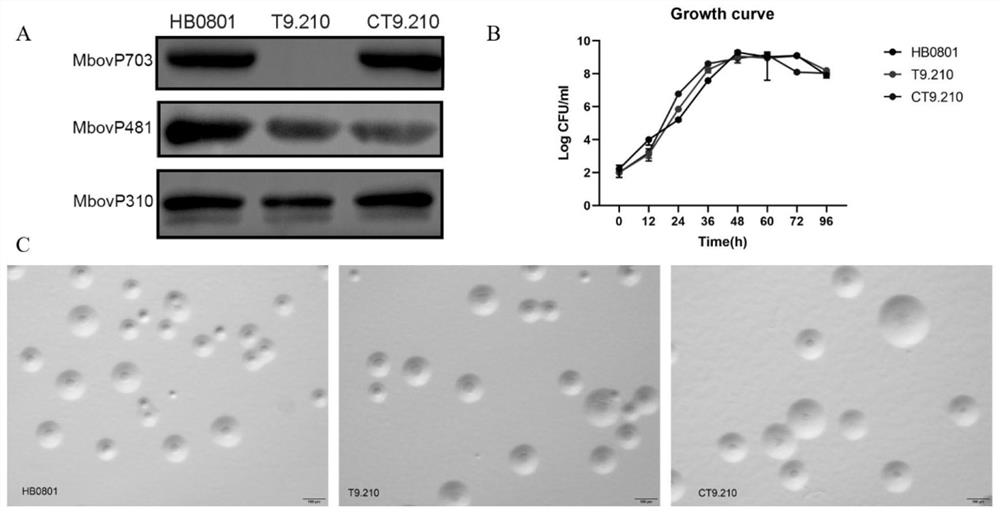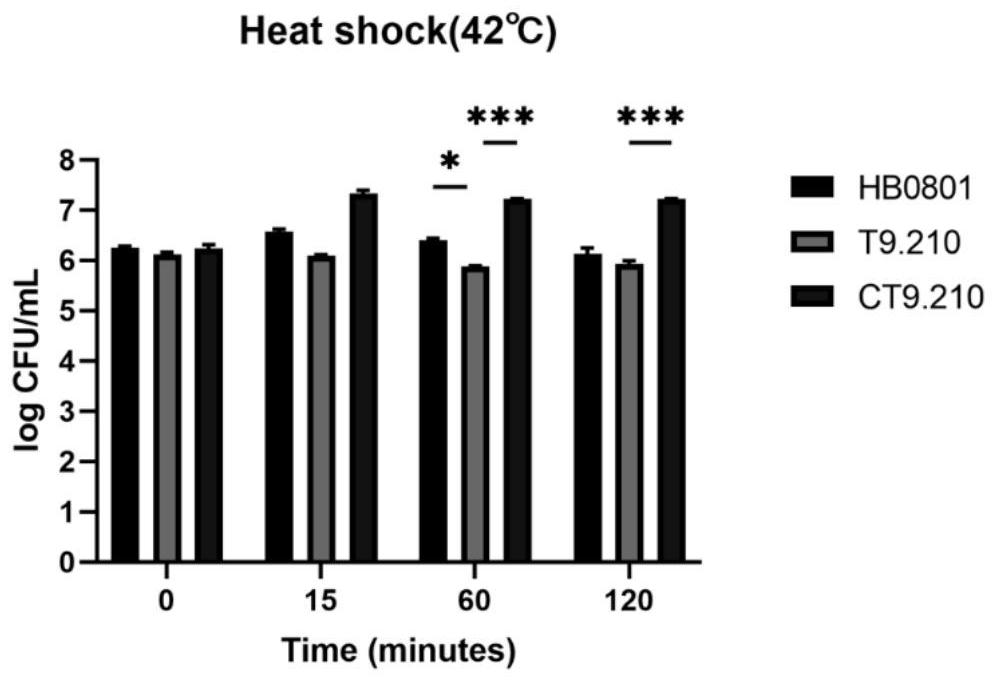Mycoplasma bovis Mbov0703 gene mutant strain and application thereof
A Mycoplasma bovis, gene technology, applied in the direction of bacterial antigen components, microbe-based methods, microbes, etc., can solve the problems of molecular regulation mechanism and typical virulence factors, and achieve the ability to adhere to cells and induce inflammatory reactions Effects of reduced capacity, weakened virulence, and reduced biofilm-forming ability
- Summary
- Abstract
- Description
- Claims
- Application Information
AI Technical Summary
Problems solved by technology
Method used
Image
Examples
Embodiment 1
[0024] Example 1: Construction and identification of Mycoplasma bovis Mbov_0703 gene deletion / apoptosis strain
[0025] 1.1 Construction of Mycoplasma bovis Mbov_0703 gene deletion / replenishment strain
[0026]The Mbov_0703 gene deletion strain T9.210 was screened out from the Mbov_0703 mutant library constructed earlier in the laboratory, and the Mbov_0703 gene deletion was verified at the protein level by Western blot; Amplify the Mbov_0703 gene, clone the target fragment into the pOH / P plasmid, and obtain a complementing plasmid; use the transformation method mediated by PEG8000 (purchased from SIGMA) to transform the constructed recombinant plasmid into the Mbov_0703 gene deletion strain, and in a solid culture Culture medium for 3-7 days, and select positive clones by resistance. After the positive clones were expanded and cultured, the total protein of the bacteria was extracted, and the expression of MbovP0703 protein in the recombinant bacteria was verified by Western...
Embodiment 2
[0029] Example 2: Environmental resistance and biofilm formation ability of mutants
[0030] 2.1 Determination of the viability of M. bovis mutant strain T9.210 under heat-stimulated conditions
[0031] Take 1 ml of Mycoplasma bovis HB0801 grown in logarithmic phase, the mutant strain T9.210 and the complementing strain CT9.210 for colony counting, and adjust to 10 according to the counting results. 6 CFU / ml, and then continue to culture at 42°C for 15min, 60min, 120min, and take 100μl of bacterial solution for colony counting within the specified time. The results showed that after culturing for 60 min, the number of colonies of the mutant strain was significantly lower than that of the wild strain and the complemented strain ( image 3 ).
[0032] 2.2 Biofilm formation assay of M. bovis mutant strain T9.210
[0033] Take Mycoplasma bovis HB0801, mutant strain T9.210 and replenishing strain CT9.210 grown in logarithmic phase, add 10 μl of bacterial liquid to a 48-well cell...
Embodiment 3
[0035] Example 3: Determination of the ability of mutant strains to adhere to EBL of bovine lung epithelial cells
[0036] Take an appropriate amount of counted Mycoplasma bovis HB0801, the mutant strain T9.210 and the replenishing strain CT9.210, washed three times with PBS, and resuspended in an equal volume with the cell culture medium DMEM, and infected EBL according to the ratio of infection ratio (MOI) to 1000 cells at 37 °C, 5% CO 2 Infected for 30min, 60min, and 120min respectively under the conditions, washed three times with sterile PBS, added a certain amount of DMEM medium, and repeatedly freeze-thawed at -80°C / 37°C to fully lyse the cells, and then counted CFU. The results showed that the adhesion ability of T9.210 was significantly lower than that of the wild strain and the complementing strain after 30min and 60min adhesion ( Figure 5 ).
PUM
 Login to View More
Login to View More Abstract
Description
Claims
Application Information
 Login to View More
Login to View More - Generate Ideas
- Intellectual Property
- Life Sciences
- Materials
- Tech Scout
- Unparalleled Data Quality
- Higher Quality Content
- 60% Fewer Hallucinations
Browse by: Latest US Patents, China's latest patents, Technical Efficacy Thesaurus, Application Domain, Technology Topic, Popular Technical Reports.
© 2025 PatSnap. All rights reserved.Legal|Privacy policy|Modern Slavery Act Transparency Statement|Sitemap|About US| Contact US: help@patsnap.com



